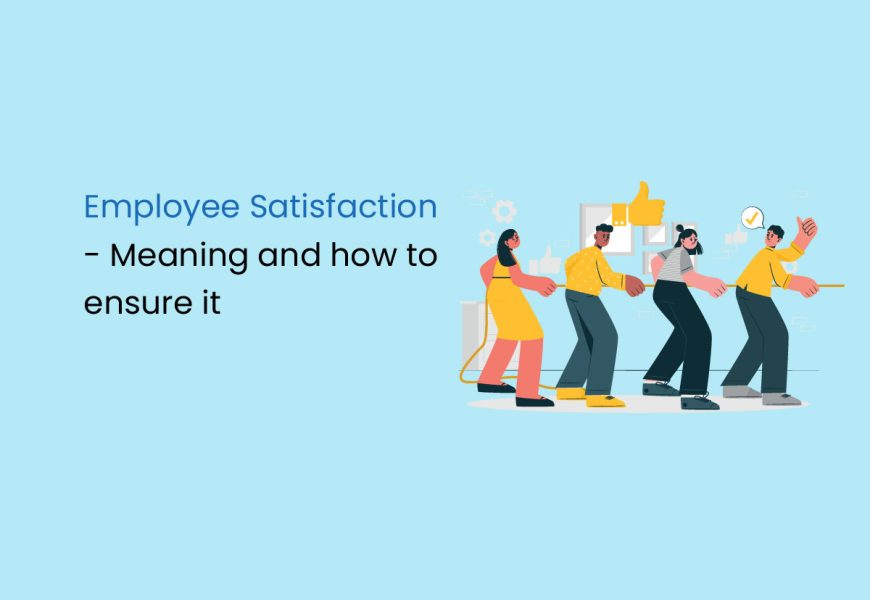Organisations are placing heightened significance on prioritising employee satisfaction as a pivotal factor for achieving success. Recognising that a contented workforce is key to enhanced productivity, efficiency, and prolonged employee retention, companies are increasingly investing in strategies to elevate employee satisfaction.
Beyond mere monetary compensation, the pursuit of improved employee satisfaction entails a comprehensive enhancement of factors impacting an individual’s overall well-being, engagement, and motivation. Elements such as work-life balance, accessible career growth opportunities, acknowledgement, and the cultivation of a supportive company culture are integral components that organizations need to address. Embracing a holistic approach is imperative to foster an environment where employees not only feel valued but also experience a sense of fulfilment.
In an upcoming article on employee satisfaction, we will delve deeper into the multifaceted aspects of this crucial workplace dynamic.
What is Employee Satisfaction?
Employee satisfaction is a term used to gauge whether employees are content and fulfilling their needs and desires within their workplace. The critical aspect of employee satisfaction is that content employees should effectively perform their job responsibilities and make valuable contributions as required by the employer.
Within the Human Capital industry, employee satisfaction is a broader concept encompassing how content or satisfied employees are with various aspects such as their job roles, overall employee experience, and the organisations they are associated with. It serves as a vital metric, offering insights into the overall organisational well-being. Many companies utilise regular surveys to assess employee satisfaction and monitor trends over time. High satisfaction levels signify employees’ happiness with their treatment by the employer.
Distinguishing Employee Satisfaction and Engagement
Although employee satisfaction and engagement are often used interchangeably, they are distinct concepts. While engagement contributes to overall satisfaction, the two are not synonymous. Satisfaction, crucial for retention, does not necessarily predict performance. On the other hand, engagement, reflecting an employee’s passion for their work, is directly linked to output. The ideal scenario involves a balance where satisfaction results from tangible factors like compensation and benefits coupled with intangible elements such as engagement, recognition, and effective leadership.
Balancing Employee Satisfaction and Engagement
An organisation that neglects either aspect may face challenges. It could have a complacent team with materially satisfied but unengaged employees who merely fulfil the minimum requirements to keep their jobs. Conversely, a highly engaged workforce might seek opportunities elsewhere if their material needs are not addressed. Achieving a harmonious balance ensures a satisfied and engaged workforce, contributing positively to the organisation’s success.
Why is Employee Satisfaction Important?
The advantages of employee satisfaction extend across various dimensions, fostering a thriving workplace with far-reaching positive outcomes. When team members derive enjoyment from their roles, not only are they more likely to accomplish their tasks efficiently, but they also exhibit higher retention rates, contributing to the overall success of the company. Furthermore, the ripple effect of employee satisfaction often results in increased customer satisfaction.
Satisfied employees typically demonstrate enhanced focus and take pride in their work, creating a work environment characterized by dedication and commitment. The collective impact of contented employees translates into entire teams going above and beyond to achieve organisational goals and elevate the quality of their output.
Beyond individual contributions, happy employees forge strong internal relationships, fostering greater collaboration and a willingness to share information. This collaborative spirit enhances overall performance and efficiency within the workplace.
Employee satisfaction plays a crucial role in staff retention. Research conducted by the iOpener Institute over 12 years indicates that the happiest workers tend to stay with their companies for twice as long as their less satisfied counterparts. Considering the substantial costs associated with employee turnover, as estimated by Gallup, organisations stand to benefit economically by prioritising employee satisfaction. Replacing an existing employee is estimated to cost anywhere from half to two times their salary.
A critical aspect often overlooked is that employees desire reasons to stay with their organisations, with over half expressing that their employers fall short of demonstrating sufficient care about their satisfaction. Gallup’s findings reveal that 52 percent of departing employees believe their decision to leave could have been prevented through a focus on satisfaction, primarily by their managers or organisations.
Beyond the internal dynamics, happy employees contribute positively to customer interactions by infusing cheerfulness and enthusiasm. This positive attitude not only puts customers at ease but also encourages the establishment of enduring relationships with the brand.
Moreover, the positive impact of employee satisfaction extends to customer experience metrics. Research demonstrates a correlation between companies with high employee experience metrics and those achieving high customer experience metrics. Therefore, investments in improving conditions for employees often result in a domino effect, positively influencing areas such as customer satisfaction and overall revenue.
What Drives Employee Satisfaction?
- Supportive Environment: A supportive workplace is foundational to employee satisfaction. It involves nurturing the success of employees by removing obstacles, providing essential tools, and creating an atmosphere where they feel valued. Recognising and rewarding their efforts is crucial to reinforcing a sense of appreciation.
- Inclusive Culture: An inclusive workplace promotes diversity and encourages employees to contribute their unique ideas. This cultural inclusivity creates an environment where employees feel like they fit into the company and sense a profound level of respect and unity.
- Professional Development: Offering opportunities for professional growth is essential for employee satisfaction. Companies that invest in initiatives such as mentorship programs, training workshops, and clear promotion opportunities not only enhance the skills of their workforce but also demonstrate a commitment to their employees’ long-term success.
Reasons for Employee Dissatisfaction
Before initiating efforts to enhance employee satisfaction, it’s crucial to delve into the root causes of employee dissatisfaction. The following key factors have been identified as primary contributors to employee discontent:
Low Compensation
Stagnant pay below industry standards can lead to frustration, fostering feelings of being undervalued. Recognising and rewarding high performers is pivotal to preventing resentment. To address this, organisations must ensure that compensation is fair, competitive, and reflective of individual contributions. Highlighting non-monetary benefits and implementing a robust performance appraisal system are essential elements in cultivating employee contentment.
Lack of Career Growth
Insufficient training and advancement opportunities contribute to a sense of stagnation among employees. They desire clear paths for career development. Organizations should invest in employee training programs, provide stretch assignments, and establish mentorship initiatives. These measures collectively instill motivation, purpose, and upward trajectory in employees’ careers.
Poor Management
Disengaged or incompetent management can quickly erode employee satisfaction. Effective leadership involves guidance, advocacy, and feedback. To tackle issues with poor management, organisations must focus on management training, address performance issues proactively, and ensure the hiring of leaders with the right competencies. This transformation turns poor management into effective leadership, fostering a culture of accountability and continuous improvement.
Poor Relations with Co-Workers/Managers
Workplace toxicity arising from unresolved conflicts, lack of trust, and unprofessional behaviour significantly impacts employee satisfaction. Organisations must prioritise building an inclusive culture, promptly addressing conflicts, and fostering mutual understanding among team members.
Lack of Appreciation and Recognition
Employees seek recognition for their efforts and contributions. Insufficient praise can lead to feelings of being overlooked. Implementing regular recognition practices, including rewards for exceptional work, is critical in creating a positive reinforcement culture that enhances overall employee satisfaction.
Poor Work-Life Balance
Overwork, burnout, and chronic stress resulting from poor work-life balance impact mental and physical well-being. Lack of downtime affects morale and personal priorities. Organisations must prioritise work-life balance, discourage overwork, and acknowledge and support employees’ personal commitments. This helps in creating an environment where employees perceive their personal growth, well-being, and priorities outside of work as valued, contributing positively to overall satisfaction.
How To Ensure Employee Satisfaction
Enhance Your IT and HR Support
Ensuring that employees can swiftly obtain answers to their IT and HR queries is paramount for maintaining a happy and productive workforce. Technology-related issues or workplace dynamics can lead to distractions, impacting overall job satisfaction. The Zendesk Employee Experience Trends Report 2023 highlights that 30 percent of employees struggle with how to contact IT and HR teams, underscoring the need for improved accessibility.
To address this challenge, consider incorporating Employee Experience (EX) software tailored to provide specialised solutions. By implementing internal IT and HR support tools, organisations can establish efficient communication channels between departments, facilitating prompt query resolution. Automation of workflows within these tools enables HR and IT teams to prioritise and focus on tickets that require more comprehensive attention.
The adoption of EX software not only streamlines the process of seeking assistance but also contributes to a more seamless and responsive work environment. Swift resolution of IT and HR queries minimises disruptions, enhancing employee satisfaction and overall productivity.
Internal Help Center
Establishing an internal help centre is crucial for enhancing employee support and productivity. It serves as a centralised resource, offering employees quick access to the information they need for effective task execution. This empowers them and simplifies the process of finding solutions.
While many companies provide internal knowledge bases, some fall short of keeping up with technological advancements. The Zendesk EX Trends Report highlights that 52 percent of employees find their EX software either difficult to use or outdated. It’s essential to regularly update and optimise knowledge management tools to ensure they effectively contribute to employee satisfaction.
Involvement in Decision Making
Involving employees in decision-making processes is key to successful policy implementation. Harvard Business School emphasises the importance of this approach in building trust and showing appreciation for individuals’ opinions, ultimately fostering employee engagement.
To facilitate this, department leaders can organise strategy sessions where team members collectively discuss and contribute ideas for achieving upcoming objectives. Providing a platform for open dialogue allows employees to have a voice in shaping the path toward success.
Career Development Roadmaps
Employees experience increased satisfaction and purpose when they understand the path to progressing to more senior roles. According to a study by the Robert Walters Group, 69 percent of millennials find career progression crucial for their engagement at work.
- Employee Experience Journey Maps: Create detailed maps outlining competencies, output expectations, compensation ranges, and values for each position.
- Mentorship Programs: Assign mentors from senior staff to new employees, facilitating guidance and addressing role-specific questions.
Regular Feedback
Waiting for an annual review to provide feedback can be detrimental to employee engagement. Gallup data reveals that employees who receive meaningful feedback on a weekly basis are nearly four times more likely to be engaged.
- Scheduled One-on-One Meetings: Encourage managers to schedule regular meetings with direct reports. Use this time to discuss strengths and growth areas, and create improvement plans when necessary.
Competitive Pay and Perks
Competitive compensation and perks are crucial for attracting and retaining top talent, yet only 55 percent of companies have a compensation strategy, as per a Payscale survey.
- Transparency in Pay Rates: Adopt transparency in determining pay rates. Regularly consult national salary surveys to ensure rates are competitive.
- Communication of Benefits: Clearly communicate if your organisation offers below-market rates but compensates with generous benefits. This transparency is vital for both prospective and current employees.
Employee Recognition and Personalized Rewards
Making employees feel seen and valued is crucial for overall job satisfaction. Personalising the work environment fosters a deeper connection. The Zendesk EX Trends Report highlights that 87 percent of EX professionals believe personalisation significantly enhances employee satisfaction.
- Beyond Names: Personalization should extend beyond using employees’ names. Tailor experiences to individual preferences and goals.
- Reward Alignment: When recognising employee performance, offer rewards that align with their interests rather than generic, one-size-fits-all prizes.
- Future Career Goals: Understand employees’ aspirations and tailor development programs to help them achieve their future career objectives.
- Mentor Matching: Instead of randomly assigning mentors, consider the communication style that resonates with the employee. This requires a blend of emotional intelligence (EQ) and intellectual intelligence (IQ).
- Communication Style: Choose mentors or leaders who communicate in a style that resonates with each individual employee.
- Recognising Individual Needs: Acknowledge and understand the diverse needs and preferences of each employee for a more emotionally intelligent approach to connection.
Promoting Work-Life Balance
A healthy work-life balance is vital for reducing stress and enhancing job satisfaction, as emphasised by a study by the IBM Institute for Business Value.
- Remote Work Opportunities: Support work-life balance by providing opportunities for remote work, where feasible.
- Parental Leave Policies: Implement supportive parental leave policies to enhance the work-life balance of your employees further.
- Employee Feedback: Gather feedback through polls or surveys to understand individual perspectives on work-life balance. Use the insights to tailor initiatives aligned with your company culture and business objectives.
- Creative Solutions: If financial constraints limit implementing popular options like unlimited paid time off, explore creative alternatives. For instance, consider offering an additional week of PTO or providing a short sabbatical after a specified tenure.
How To Measure Employee Satisfaction in the Workplace?
To ensure an accurate understanding of employee satisfaction levels, employ a combination of measurement techniques.
Employee Satisfaction Surveys
Utilise comprehensive surveys incorporating both quantitative and qualitative questions.
- Quantitative Research: Pose questions like:
- How satisfied are you with the feedback you receive at work?
- How proud are you to work at [Company Name]?
- How happy are you with your work environment?
- Have employees rank their satisfaction on a scale of 1 to 5.
- Calculation:
- Sum positive responses (4-5) and divide by the total number of responses.
- Multiply the result by 100 to get the percentage of satisfied employees.
- Monitor trends over time to gauge improvements.
- Qualitative Research: Include open-ended questions such as:
- What do you like (and dislike) most about our feedback system?
- Do you see yourself working for [Company Name] in the next two years? Why?
- What can managers do to make you feel more satisfied with your job?
- Encourage respondents to elaborate on their ratings.
Employee Net Promoter Score (eNPS)
Utilise a simple metric asking employees how likely they are to recommend the company to others seeking employment, rated on a scale from 1 to 5.
- Calculation: Categorise responses into promoters (4-5), passives (3), and detractors (1-2).
- Use the formula: eNPS = (Number of promoters / Total respondents) – (Number of detractors / Total respondents).
- Obtain a score between -100 and 100; a score above zero indicates a positive overall sentiment.
- Benchmark against industry averages; for instance, tech companies typically have an average eNPS® score of 35, according to a Nailted survey.
FAQs on Employee Satisfaction
Why is employee satisfaction important in HR?
Employee satisfaction is crucial in Human Resources for several reasons. Satisfied employees are more likely to be productive, committed, and less prone to turnover. A positive work environment, supported by high satisfaction levels, fosters better collaboration, creativity, and a sense of belonging. HR professionals focus on employee satisfaction as it directly impacts talent retention, recruitment efforts, and overall organisational success. Satisfied employees are also more likely to provide positive feedback about their workplace, enhancing the company's reputation.
What determines employee satisfaction?
Employee satisfaction is influenced by various factors:
- Work Environment: A positive and inclusive workplace fosters satisfaction.
- Job Content: Employees find satisfaction in roles that align with their skills and interests.
- Compensation and Benefits: Fair and competitive compensation, along with good benefits, contributes to satisfaction.
- Work-Life Balance: Adequate time for personal and family activities enhances satisfaction.
- Career Growth Opportunities: Clear pathways for career development and growth positively impact satisfaction.
- Relationships: Healthy relationships with colleagues and supervisors are vital for satisfaction.
How can employees be satisfied?
To enhance employee satisfaction:
- Communication: Open and transparent communication fosters trust and understanding.
- Recognition: Acknowledging and appreciating employees' contributions boosts satisfaction.
- Professional Development: Providing opportunities for skill development and career advancement is crucial.
- Flexibility: Offering flexible work arrangements enhances work-life balance.
- Well-being Programs: Implementing wellness initiatives supports employee health and satisfaction.
- Fair Policies: Ensuring fairness in policies and procedures contributes to satisfaction.





















